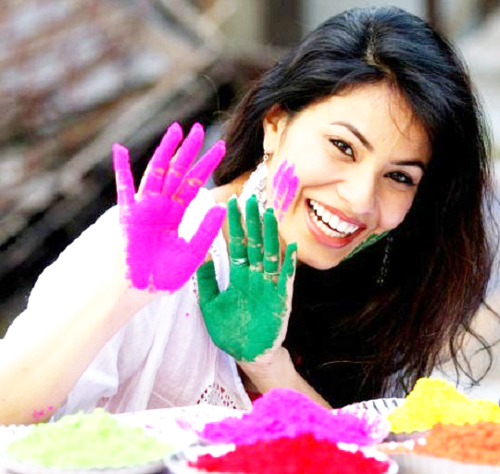Shahnaz Husain
Holi is a festival of colours that owes its origin to ancient India. According to Ayurvedic texts, during those times, vegetable dyes and natural ingredients were used to prepare colours for Holi. Today, wet colours and the dry colour, known as “Gulal,” contain chemical ingredients and particles of mica and even lead. These not only irritate the skin and scalp, but are actually harmful to both health and beauty. They disrupt the normal acid-alkaline balance of the skin and scalp, which can leave them pre-disposed to allergies, rashes, sensitivity and eruptions. The skin can also suffer from dryness, flaking and rough reddish patches. The dry colours and chemicals can affect the hair too. They collect on the scalp causing dryness and itching. The hair texture also suffers, becoming dry, rough and unmanageable.
Many Ayurvedic ingredients also help in caring for the skin and hair after playing Holi. Neem is one of the most versatile ingredients for both skin and hair care and easily available. Neem leaf infusions can be used to wash the skin and hair to heal rashes and eruptions. First boil water and add the neem leaves to the hot water. Do not boil the leaves, but cover it and let it stand in the water overnight. Next day, strain the water and use it to wash the skin and hair. Make a paste of the leaves and apply it on the skin and scalp. Leave it on for half an hour and wash off. It will also help itchy conditions.
Neem can also be used with oil for head massage. Heat 250 ml pure coconut, or sesame seed oil. Take a handful of neem leaves and add it to the oil. Keep in the sun during the day for 4 or 5 days. Strain the leaves and keep the oil for use. This relieves itching and restores the scalp’s normal balances.
Turmeric has many healing properties. It is a natural antiseptic and has an anti-inflammatory action. It helps to soften the skin and remove tan. Mix together 4 parts of curd, add one part honey and very little turmeric. Apply on the face, neck and arms daily, for a few days after Holi. Wash off after 20 minutes. It makes the skin soft, smooth and bright.
Crush sesame seeds (til) coarsely and soak in water overnight. The next day, strain it and use the milky liquid to wash the face, neck and arms. This helps to soothe sunburn. Sesame seeds have sun-protective properties and recent research has revealed that Sesame seeds have SPF of 6 and also have soothing and protective effects on the skin.
The gel or juice of an aloe vera plant were also applied during the ancient times. Aloe vera moisturizes the skin, relieving dryness. Applying fresh Aloe Vera gel also soothes sun burn. It contains zinc, which is anti-inflammatory. It can also be applied as a hair pack. Take one tablespoon besan, one teaspoon each orange peel powder and curd and one tablespoon aloe vera gel. Mix together and apply on the skin, washing it off after 20 minutes.
Sandalwood essential oil has powerful healing properties. It can be added in the right proportions to pressed oils and lotions to care for the skin and hair. Add 8 drops of sandalwood essential oil to 100 ml pressed oil, like olive oil or til oil. Apply on the skin to soothe and heal eruptions. Add 8 drops sandalwood oil to 100 ml rose water. Keep in the fridge and use it to tone the skin. This also has a cooling and healing effect on rashy conditions.
Marigold helps to soothe skin and scalp irritation, which is common after holi. Add a handful of fresh or dried marigold flowers to three cups of hot water. Allow it to stand for an hour. Strain and cool the water and use it to rinse the face and hair. Or, take a cup of marigold flowers. Crush them with fingers and add 2 teaspoons olive oil. Blend well. Add the mixture to warm bath water.
The knowledge contained in the ancient texts has not only stood the test of time, but is actually very relevant to modern times. In fact, we should go “back to the future” and celebrate a safe Ayurvedic holi.
Trending Now
E-Paper


